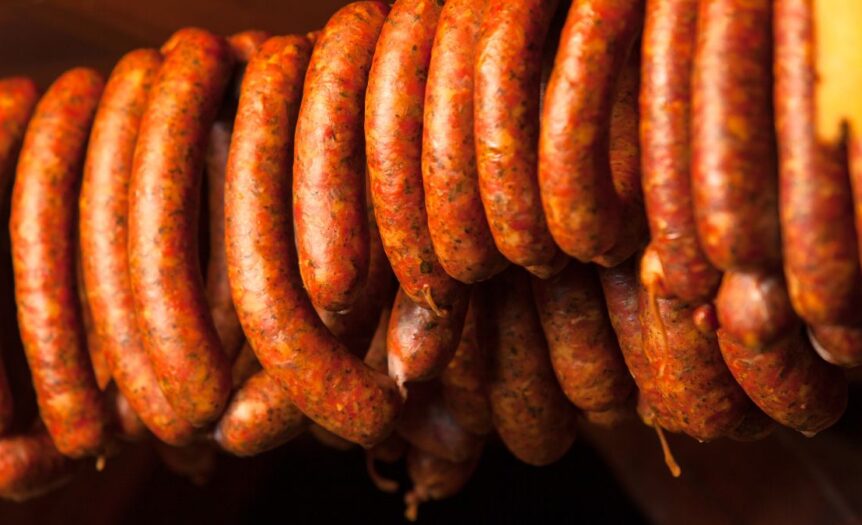If you’ve ever enjoyed the satisfaction of hearing a classic sausage snap, you know it’s all thanks to that delicious sausage casing. While its main purpose is to keep the sausage together in that classic shape, sausage casing can also affect the overall flavor and texture of the sausage. If you’re thinking of making homemade sausage or want to pick the best one for your next dish, take a closer look at the different types of sausage casings.
Natural Casings
The small intestine contains a collagen-packed lining known as the submucosa, which is what sausage casings have been made of for centuries. The submucosa can be taken from various animals, such as pigs, sheep, goats, horses, and cows. This is the kind of casing used to make a sausage that packs a flavorful punch, like the andouille sausage you’d typically use when cooking a Cajun seafood and sausage boil. Natural casings can be used for fresh or smoked sausage, are tender, flexible, and durable, and give you that iconic snap.
Cellulose Casings
Cellulose casings are a type of man-made casing typically made from wood pulp, which results in a very stretchy casing that’s easy to fill and remove. While they’re durable and help keep the sausage filling together, these casings aren’t edible, so the sausage must be peeled before eating. You’ll see these casings used for hot dogs, skinless sausages, and frankfurters. These casings are best suited for large-scale automatic manufacturing rather than use by a home chef.
Collagen Casings
Collagen casings are technically man-made, but they’re derived from the bones or hide of a cow or pig. Although they are edible in most cases, they’re typically removed from the sausage before consumption. However, keep in mind that not all collagen casings are edible, so be aware of what you’re buying. These casings are typically used to make snack sticks, smoked sausage, and bratwurst. These casings have a minimal snap when you bite into them, but they do come in sheets, which makes them easy to load on the stuffing horn.
With your new guide to the different types of casings, you’re ready to make your own delicious sausage at home according to your exact preferences.










 Deering Estate
Deering Estate
 Massage Envy South Miami
Massage Envy South Miami
 Calla Blow Dry
Calla Blow Dry
 My Derma Clinic
My Derma Clinic
 Sushi Maki
Sushi Maki
 Sports Grill
Sports Grill
 The Healthy Kitchen
The Healthy Kitchen
 Golden Rule Seafood
Golden Rule Seafood
 Malanga Cuban Café
Malanga Cuban Café

 Kathleen Ballard
Kathleen Ballard
 Panter, Panter & Sampedro
Panter, Panter & Sampedro
 Vintage Liquors
Vintage Liquors
 The Dog from Ipanema
The Dog from Ipanema
 Rubinstein Family Chiropractic
Rubinstein Family Chiropractic
 Your Pet’s Best
Your Pet’s Best
 Indigo Republic
Indigo Republic




 ATR Luxury Homes
ATR Luxury Homes


 2112 Design Studio
2112 Design Studio
 Hamilton Fox & Company
Hamilton Fox & Company
 Creative Design Services
Creative Design Services
 Best Pest Professionals
Best Pest Professionals
 HD Tree Services
HD Tree Services
 Trinity Air Conditioning Company
Trinity Air Conditioning Company
 Cisca Construction & Development
Cisca Construction & Development
 Mosquito Joe
Mosquito Joe
 Cutler Bay Solar Solutions
Cutler Bay Solar Solutions


 Miami Royal Ballet & Dance
Miami Royal Ballet & Dance
 Christopher Columbus
Christopher Columbus
 Pineview Preschools
Pineview Preschools
 Westminster
Westminster
 Carrollton
Carrollton
 Lil’ Jungle
Lil’ Jungle
 Frost Science Museum
Frost Science Museum
 Palmer Trinity School
Palmer Trinity School
 South Florida Music
South Florida Music
 Pinecrest Orthodontics
Pinecrest Orthodontics
 Dr. Bob Pediatric Dentist
Dr. Bob Pediatric Dentist
 d.pediatrics
d.pediatrics
 South Miami Women’s Health
South Miami Women’s Health

 The Spot Barbershop
The Spot Barbershop
 My Derma Clinic
My Derma Clinic




 Miami Dance Project
Miami Dance Project

 Rubinstein Family Chiropractic
Rubinstein Family Chiropractic
 Indigo Republic
Indigo Republic

 Safes Universe
Safes Universe
 Vintage Liquors
Vintage Liquors
 Evenings Delight
Evenings Delight





 Atchana’s Homegrown Thai
Atchana’s Homegrown Thai
 Baptist Health South Florida
Baptist Health South Florida

 Laser Eye Center of Miami
Laser Eye Center of Miami
 Visiting Angels
Visiting Angels
 OpusCare of South Florida
OpusCare of South Florida

 Your Pet’s Best
Your Pet’s Best





 HD Tree Services
HD Tree Services
 Hamilton Fox & Company
Hamilton Fox & Company


 Creative Design Services
Creative Design Services